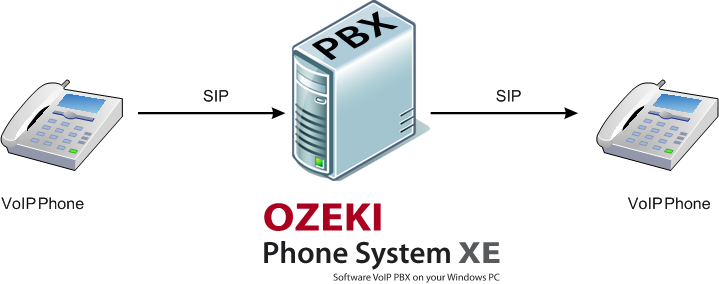VoIP protocols
In order to use VoIP technology in the corporate communication system some protocols need to be implemented. The most common VoIP protocols are SIP and H323 but of course there are also other standards for VoIP connection. These protocols are responsible for determining rules that defines how VoIP network elements communicate with each other. In this section, we will focus on these VoIP protocols.
Your Ozeki Phone System works with VoIP technology, using several protocols that will be explained in details below. The method of a VoIP call managed through your Ozeki Phone System is made like Figure 1 shows:

Introduction
Protocols are standards that describe how network elements communicate with each other. For transferring audio-video packets RTP (Real-Time Transport Protocol) is used worldwide. Before transmission, however, other protocols are also required for identifying remote devices and selecting the mediaplayer for transmission. They are the so-called call notification protocols. Basically, VoIP connections can be determined by the following protocols: SIP, RFC, UDP, SDP, RTP, RTCP, H323. Below you can find details about the three most common protocols: SIP, RTP and H323 protocols.
VoIP protocols
- SIP
- User agent (UA): User Agent refers to a local network end point that handles SIP connections. It can be a client (User Agent Client) or a server (User Agent Server). User Agent Client initiates calls and sends SIP requests, while User Agent Server monitors incoming calls, receives requests and returns SIP responses.
- SIP Proxy Server: SIP Proxy Server is a mediator and functions as a server in a SIP-based IP telephony environment. It accepts SIP requests, ensures to handle these requests and to deliver them to users.
- SIP Redirect Server: SIP Redirect Server accepts SIP requests, returns responses and delivers them to clients.
- SIP Registrar Server: SIP Registrar Server accepts registration (REGISTER) requests and places client addresses to login names or user SIP URLs.
- Gateways: Gateways are for controlling calls and converting them into another format.
- INVITE: This SIP message creates connection between user agents and includes information related to calls, the called party and media.
- ACK: This message acknowledges when the connection is created.
- BYE: It terminates the connection between two users. Any of the users can send BYE message to terminate the connection.
- CANCEL: It cancels pending requests.
- OPTIONS: It asks for information about the server, the caller and other devices. This message allows to check the media before setting up the connection.
- REGISTER: It is used by clients for login.
- RTP
- H323
SIP (Session Initiation Protocol) is an Internet communication protocol that sets up communication channels between two or more users (Figure 1). SIP protocol is defined in RFC standards.
SIP is responsible for setting up, modifying or terminating connection between two (unicast) or more parties. This connection can be, for example, a telephone call over the Internet, transmission of multimedia packets, conference handling, etc.
Similarly to HTTP (Hypertext Transfer Protocol) protocol, SIP protocol also uses HTTP request/response transaction model. These two protocols use similar header structure and both of them are text protocols. This way, SIP transactions also consist of client requests and at least one response.
Since SIP is used only for creating communication sessions, there is a need for other protocols that connect data transmitted over communication channels. SDP and RTP protocols have been designed for this purpose. SDP does not deliver media itself but it is for negotiation between end points of media type, transfer protocols, format, and all associated properties. While RTP is for transferring multimedia data.

SIP glossary
Users are identified by SIP addresses in SIP networks. The format of these SIP addresses is the following: sip:userID@domain.com. Users can register with the help of the registrar server and their SIP addresses.
SIP requests
RTP (Real-time Transport Protocol) defines a standardized package format for audio and video data transferred over the Internet. It allows real-time multimedia data delivery between two (unicast) or more parties (multicast). Due to the fact that RTP is able to ensure proper dataflow even between more parties, it is widely used for communication and entertainment systems.
RTP is often used together with RTCP (Real-time Transport Control Protocol). While RTP transports data, RTCP sends monitors transmission statistics and quality of service for participants. RTCP is primarily used for providing information regarding the quality of service.
RTP supports a wide range of multimedia formats: MPEG-, MJPEG, MPEG, etc., and it also allows to add new formats without revising RTP standards. Supported VoIP data formats
H323 is a VoIP protocol published by ITU. H323 protocol provides a basis for audio, video and data communication via IP-based networks including WANs and the Internet. Today, H323 protocol is used mainly for VoIP communication (Figure 2).
The strength of H.323 is that it makes multimedia (audio, video and data) transfer possible even via local computer networks where communication with the PSTN network is critical. H323 is the ideal solution for delivering real-time multimedia content via packet-switched networks.

Keep in mind
SIP, RTP and H323 protocols are the most widespread protocols used for VoIP communication efficiently. They are the standards that describe how participants communicate with each other during sessions. SIP is for creating, modifying or terminating communication between two or more parties. RTP is used for transferring audio and video packets between computers. While H323 protocol is for transferring multimedia content via packet-switched networks.
You can find more detailed information on VoIP technology and VoIP technology benefits, as well.
Learn Ozeki Phone System services:
- VoIP data formats
- VoIP network elements
- How to setup a webphone
- How to integrate mobile extensions into the PBX
- How to exploit SMS technology in PBX
More information
- Deatiled description of VoIP network elements
- Understanding VoIP protocols (SIP, RTP, H323)
- Supported VoIP data formats (audio, video, app control, codecs)

 Sign in
Sign in